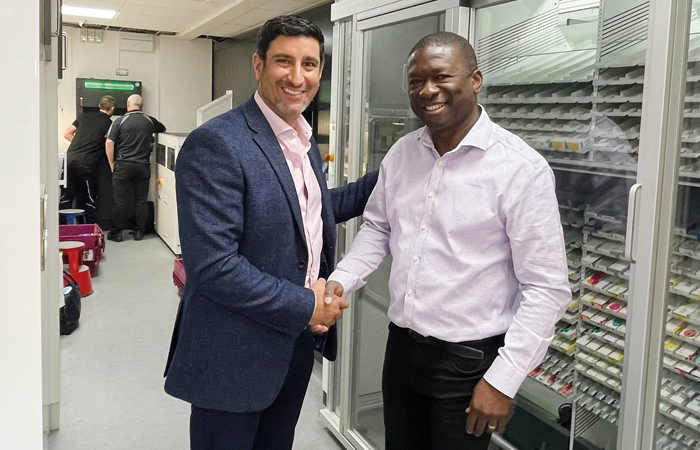In Practice
Follow this topic
Bookmark
Record learning outcomes
In the past 20 years, the population in the UK has increased by over 10 million — that’s a 17 per cent rise. However, from 2009 to 2019, the total number of GPs at any one time increased by just 100, equivalent to a mere 0.002 per cent uplift. It doesn’t take a statistician to calculate that the numbers don’t add up.
As our population increases exponentially to the number of GPs available to local communities, more patients are unable to secure an appointment and so head to their local pharmacy or A&E instead. This causes the long waiting times which have made for alarming media headlines and, more importantly, wholly unsatisfactory care provision.
The current contract in England has led to a reduction in income from dispensing, with pharmacy remuneration now intrinsically linked to the provision of services. This can include vaccinations, PCR testing, online consultation provision, phlebotomy services, medicines reviews and contraceptive advice, amongst lots of others.
Exactly how we as pharmacists are supposed to run a profitable business and tap into these extra revenue streams, when we are overburdened and under-resourced trying to deliver the ever-increasing prescription demand for patients? Whether you are an inner-city pharmacy such as mine, or a rural business, each pharmacy has its own set of distinct challenges to overcome.
Vulnerability
Covid-19 exposed a vulnerability in how modern community pharmacy works right now, with workforce pressures meaning that when staff are off sick or absent with family commitments, a pharmacy owner is often required to step in and cover – resulting in long working hours. Many pharmacists were working into the night during the pandemic, just trying to fulfil medication requests from their patients. In 2022, pharmacy teams are still feeling the fallout of Covid, both in terms of workforce capacity and staff morale.
The only way to cope with this increase in prescription demand is to harness the latest technology. As I’ve since discovered, there is no ‘one size fits all’ with technology adoption and solutions – what works for one pharmacy isn’t necessarily going to work for another even if they are located close to each other.
Decisions need to be based on patient demographics, demand, the geography of a pharmacy and future opportunities for growth.
My wife and I have had a successful business for many years, running four pharmacies in Streatham, south west London. Westbury Chemist, our flagship pharmacy, is open 365 days a year, 9am to midnight, serving the local community. The pharmacy has big dispensing demands and the dispensary was quite chaotic and disorganised before we decided to partner with Omnicell.
Staff were busy, stressed and unable to find the time to talk to patients. We felt we were delivering a poor service as we could see waiting times were increasing on the shop floor. Additionally, because we were overstretched, we were unable to tap into extra revenue via the provision of NHS and private clinical services such as ear waxing, smoking cessation and weight loss management.
Crossroads
We had come to a crossroads. We could either outsource, do nothing and thereby place a cap on volume, add more dispensary shelf space or, my final option, to automate. We decided to invest in automation.
We reached our decision by setting three core objectives:
- To increase efficiency
- To increase capacity
- To free up pharmacist time to focus on clinical services.
I’m the first to admit that this wasn’t straight- forward and, initially, the adoption process did present a number of hurdles for us to overcome – not least in having to clear out and reorganise the pharmacy, which was no mean feat. Initially we installed a VBM MDS packing robot to fill, seal and accuracy check our MDS trays.
Once this had been successfully installed and bedded in with our staff, we then invested in an RDS original pack dispensing robot, which automates the storing, management and dispensing of medication packs. Now Westbury is a thriving pharmacy, clinic and vaccination centre – our employees are happier and I’m certainly a much happier business owner!
Join us on a journey to automation
Speaking at this year’s Pharmacy Show, Cyrus Hodivala, commercial director, retail pharmacy, Omnicell UK & Ireland, highlighted the pressures on modern pharmacy owners and how technology and innovation could be the key to a successful future...
Omnicell works with pharmacists to drive financial efficiency whilst boosting patient safety and care through the reduction of medication errors. The goal is to achieve zero errors and zero waste through complete pharmacy automation, enabling teams to maximise their staffing resource and focus on face-to-face patient care and alternative revenue streams.
To realise this goal, we have developed the retail pharmacy ‘Journey to Automation’, which sets out four key steps to automating your pharmacy, safe in the knowledge that your patients are receiving their medications at the right time.
Stock management and pack handling
Do you have bulging shelves and piles of medication making stocktaking difficult? Are your staff wasting time searching for the medication they need to fulfil a prescription?
Automation starts with loading and storing all medications upon their arrival. A simple dashboard will display what medication you are storing, enabling you to stock manage with authority and confidence, identifying what you are administering every day and what you are wasting.
The Medimat Next Generation robot then identifies and delivers seamless loading and safe dispensing of medication packs to the pharmacy counter. By incorporating the unique Xpress into the robot, it allows you to handle high demand volumes quickly.
Or alternatively, for rapid stock handling, the SpeedBox offers a dedicated, high-speed, multi-pick head (with up to four heads) to channel-feed stock items to the counter.

Packing and pharmacist check
Checking packs prepared by hand is time-consuming and takes you away from revenue generating services. The VBM weekly pill pack and JVM card/pouch packing solutions prepare MDS packs for patients, saving manual time and ensuring your patients receive the right medication and dose with complete accuracy.
Safe vision-checking technology verifies every pill by colour, size and shape. By linking automated packing to your PMR system, you will know exactly what medication you have packed, for which patient, and when. The VBM has a throughput of 35-40 filled, checked and sealed blister cards per hour, which is easily scalable with multiple machines.
Safe, secure collection
Making sure your patients receive their medication on time is a critical step in ensuring they stick to their regimen. Searching for completed medication bags can be time-consuming and inconvenient for your patients.
Pharmaself24 can be customised to fit into your pharmacy workflow, allowing you to pre-load a kiosk with your patient’s medication bags. Patients simply input a unique number to automatically dispense their medication, making prescription collection safe and convenient, 24 hours a day.
Administering medication
You know the risks associated with medication adherence – factors made worse in most care facilities by time-consuming paper-based medication audits, poor record-keeping and missed signatures.
Harnessing electronic medication administration record software (eMAR) makes the process of ensuring every care home resident receives the right medication at the right time safer and easy with simple barcode scanning.
Partner with original packs or blister packaging to automate the entire care home medication management system – making it safe for patients, simple for staff and, above all, improving compliance. Open API means you can integrate your eMAR with any electronic care planning system, allowing you to communicate directly with local care homes in a two-way partnership.
For more information email: UKMASales@omnicell.com or visit the Omnicell website.


